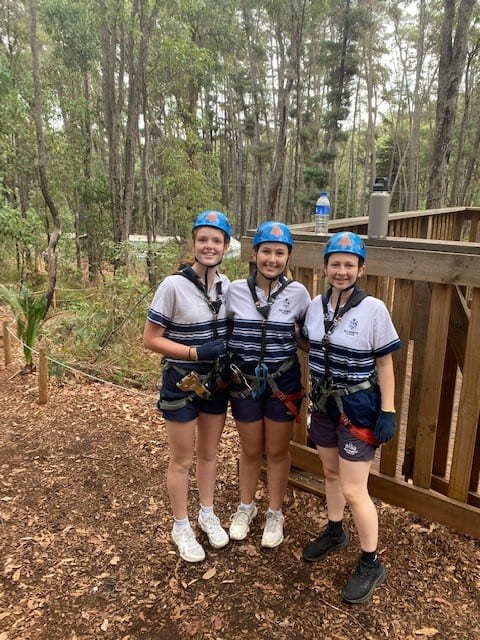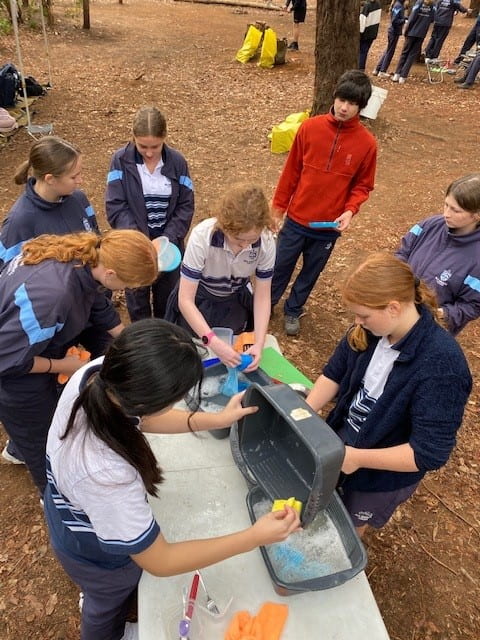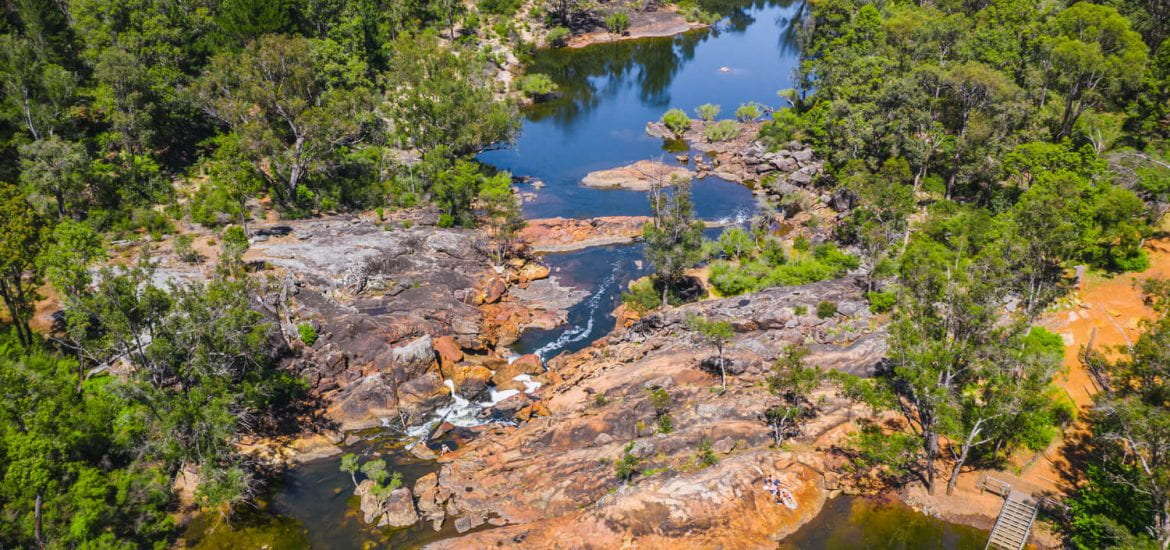Semester 1 Lock has been an amazing experience I have learnt many new skills which can be used in the future. The topics we got to focus on were Rock Climbing and Knots, Kayaking and Bush cooking. Later in the semester, all the classes were meant to go on a 3-day camp to Honeymoon Pool, Worsley. But because of covid, the camp had to change to a day trip to Dwellingup. When we were in Dwellingup, we had to incorporate the topics we had focused on this semester into the activities on the day. For rock climbing, we did treetop adventures, kayaking at Lane Pool Reserve, and bush cooking at Nanga Mill.
Rock Climbing and Knots
At the start of the lock unit, we first visited rock climbing and learnt about all the rules and how to belay, climb and how to have a safe environment when rock climbing. When learning about it we had the 7 H’s we had to remember before starting our climb Helmet, Hair, Harness, Hardware, Hands, Hoofs, Happy. Helmet, we had to make sure it was on properly and the gap between our forehead and helmet was only 2 fingers and the chin strap had to be tucked away. Hair, we had to make sure if you had long hair it was tied up and tucked into your shirt. Harness the harness was attached properly and all the straps were tucked away. Hardware, we had to make sure we had all clips and were attached properly to the rope. Hands we had to have gloves when belaying to prevent rope burn and so we could have a good grip. Hoofs we had to make sure we had enclosed shoes and our shoelaces were tied up. Happy that you are in a good mood and are ready to climb. We also focused a lot on knots during this unit we learnt many different knots that will help us when we don’t realise it. We learn how to do a basic knot to a double fisherman knot. In Dwellingup we got to experience treetop adventures which was an amazing experience. There were courses ranges from easy to very difficult I did an easy zipline one, the red course which was pretty difficult and the black course which was the one before the extreme course and it was very difficult. The capabilities I used during this unit were resilient because I had to push through even when I wanted to give up, I had to continue. I had to use Effective Communication when climbing and belaying to make sure the climber/belayer was also safe.
Kayaking
Kayaking this semester has been a very good experience we started off with travelling down to Shelly Foreshore during our double periods to do kayaking and learn all the skills. In the first few lessons, we focused on all the different aspects of kayaking like what a skirt is and how to set up your kayak, enter the water safely, pack up and raft up which was used a lot when we had to group up and talk to one another (the basics). We learnt Different types of paddling methods like travelling forward, backwards, in circles, etc. We also learnt about what to do if our kayak flips over and our body is submerged underwater, you can either use your hips to bring yourself back up or rip off the skirt and empty the water from the kayak using another person’s kayak. Another important skill that was very important for the Dwellingup day trip was dropping in from a high spot when you can’t just hop in the kayak. At Shelly Foreshore we got pushed facing backwards off the jetty into the water to get used to this experience. The lessons later in the semester were mainly just travelling around the Shelly Foreshore getting more experienced and confident for when we went to Dwellingup and if we ever did kayaking outside of school, we would have a good experience and skill. To make kayaking more exciting at the end of most lessons we would play a similar game to Water polo but in kayaks. When going on the day trip to Dwellingup we travelled to Lane Pool Reserve and since they had road works at the time, we lost a lot of valuable time that could have been spent kayaking but we made up for the time we had lost because as soon as we arrived people were already entering the water via the stairs. This was where the skill of dropping in came to be important because only 2 out of 20 something kids flipped when we entered the water. Some of the capabilities I used during kayaking were organisation by having to remember to bring all the kayak clothes, towels etc. I used problem-solving because earlier in the course I struggled a bit with kayaking, and I had to problem solve when I accidentally forget something in my kayak bag.
Bush Cooking
Bush Cooking this semester we have only just started this course, but we are doing a MasterChef Challenge. Where we make meals during our double periods. In my most recent cook, my group and I made vegetarian penne pasta. Throughout the course of bush cooking, I have learnt how to start fires, which includes finding the layers you need. The layers are kindling, which is leaves, dried grass, etc. then there are all the different sized sticks (small, medium, large) then at the end you put Jarrahwood to keep the fire alive. You can put the fires in different structures to get the fire started a “tepee” or a “house”. When we went on the Dwellingup day trip, we were able to make food on the Nanga Mill campsite. My class was assigned brunch and my group decided to cook breakfast wraps it was a very different experience from working on the fires at school since these had been used by the public and some were not in very good condition. We spent a lot of the time cleaning the pan on top of the fire because when we first tried to cook the food came out coated with charcoal. But in the end, the food ended up tasting really good. Some of the capabilities I used were being organised by making sure I bring all the food. Collaborative because we had to work as a team and cook together and also, we had to problem solve a lot when someone forgot a food item, a team member wasn’t there, etc.
Leave no Trace
Leave No Trace is a way of keeping an area clean and sustaining the environment for generations to come so many can enjoy it. There are 7 principles:
1- plan and prepare ahead of your trip so you know where you are staying, what’s the weather going to be like and the rules and regulations of the area
2- travel and camp on durable surfaces make sure you are not running the natural environment when choosing where to camp and drive for example drive on proper 4WD tracks and don’t damage plants and be very careful of animals around you.
3- dispose of waste properly put it in the proper bins and don’t get just drop it on the side of the road. Make sure you don’t litter.
4- leave what you find for example when you go to the beach leave shells how they are don’t take any home that’s why at many beaches it is harder to find big, gorgeous shells and they are considered rare.
5- minimize campfire impacts when you pick where to start your fire use an area where a fire has been before, if possible, use dead/fallen wood and don’t surround it with rocks because it can damage the rocks also choose a clear location and where the wind will blow flames away from tents/flora and fauna
6- respect wildlife by observing them from a distance, never feed them, dispose of food and waste properly and only touch animals if they are sick or injured
7- be considerate of others by being respectful of noise levels when camping and when on trails the congestion of the path. Leave artifacts for others to enjoy etc.

Cooking with Nicole 
Treetop Adventures with Sophie and Abbey 
Washing Up
